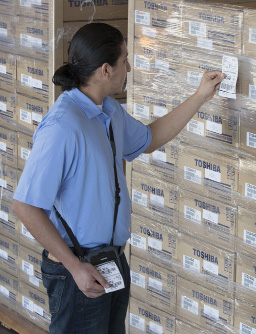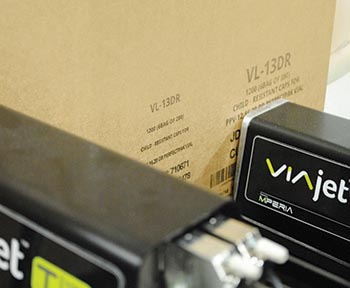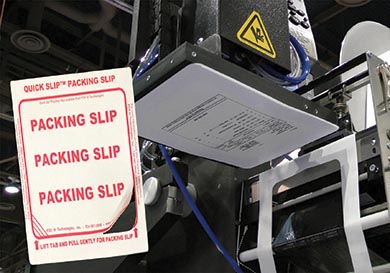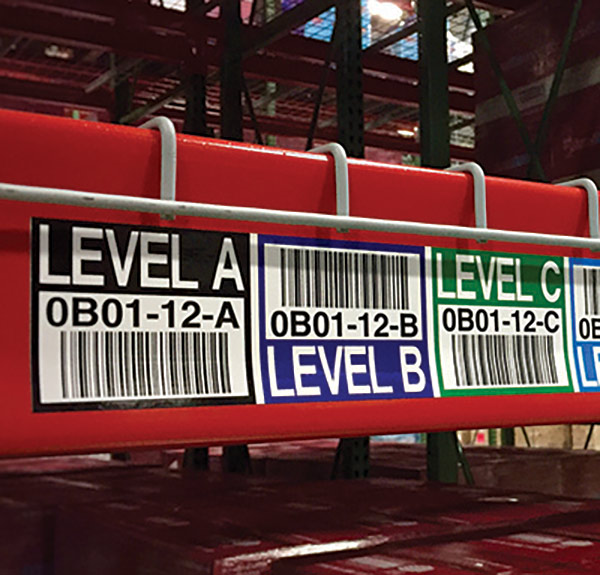We’re going to need to see some identification…
To address the AIDC challenges of e-commerce and omni-channel, labeling and marking suppliers are ensuring the information contained within each printed bar code is read with 100% accuracy every time.
As documented over the past few years in Peerless Research Group’s “Annual Warehouse and Distribution Center (DC) Operations Survey,” more operations are dealing with the unrelenting expansion and demands of e-commerce and omni-channel retail order fulfillment. In response, investments in larger facilities to hold more stock keeping units (SKUs) in inventory have consistently been on the rise, with companies reporting plans to spend an average of more than $378,000 on information system (IS) solutions alone, according to the 2017 survey.
Among that intended IS spend are investments in technologies for identification of inventory, both for locating it in the warehouse and labeling it after it’s packaged for direct-to-consumer shipping. To address the automatic identification and data capture (AIDC) challenges of e-commerce and omni-channel retail fulfillment DCs, labeling and marking suppliers have added new features to their solutions to ensure the information contained within each printed bar code, regardless of its form or purpose, is read with 100% accuracy every time.
Over the next few pages, Modern takes a look at some of the latest developments in label printers and applicators, direct carton marking print engines and storage location identification labels that help operations keep better track of inventory within the four walls as well as deliver clear destination information on outbound shipments.
Label printers/applicators engineered to minimize waste, ensure adhesion
To help shippers keep pace with the exponential increase in labeling individual parcels while still minimizing costs and consumables waste, Toshiba America Business Solutions has developed several new features for its thermal bar code printers, explains Theresa Lee, product manager.
 “We just introduced the industrial, high-speed B-EX6T, capable of printing 6-inch wide labels in lengths up to nearly 60 inches,” Lee explains. “What makes it unique is its integrated ‘ribbon save’ technology, meaning the printer pre-scans the incoming imprint data to ensure that the ribbon only advances when printing is required.”
“We just introduced the industrial, high-speed B-EX6T, capable of printing 6-inch wide labels in lengths up to nearly 60 inches,” Lee explains. “What makes it unique is its integrated ‘ribbon save’ technology, meaning the printer pre-scans the incoming imprint data to ensure that the ribbon only advances when printing is required.”
Doing so enables the printer to save ribbon with each print, maximizing ribbon use and minimizing waste. This also applies for pre-printed or flexographic labels, which often contain standard information when only variable information is required to print. Further, the unit’s print head is warrantied for 3 million inches—three times longer than competitive models. It also accommodates large ribbon capacity of up to 2,625 feet.
“Print heads also get wear and tear and must be replaced periodically to ensure print quality,” continues Lee. “These new features save users cost and downtime, as the ribbon and print head don’t have to be replaced as often.”
Lee also notes a tremendous uptick in portable printer use within warehouses and by parcel carriers. “If the bar code on a shipment label is not scan-readable due to a smeared imprint or low toner, an operator or driver can create and print a new label on the spot and place it directly over top of the unreadable one,” she says. “That ensures the package is properly routed and delivered on time.”
The jump in individual parcel shipments means it’s not only imperative that a label be readable, but that it also adheres to the package itself.
“As more companies move to automated print-and-apply technologies, we’ve heard concerns from some carriers that not every label sticks to every box or envelope,” says Rick Fox, president and CEO of FOX IV Technologies. “They’re issuing charge backs for missing labels, and the customer doesn’t receive the package when expected.”
Several factors can negatively impact label adhesion, says Fox. “If a label applicator is equipped with a blow-on applicator, the air pressure may not be strong enough to ensure the label sticks. For that reason, we use a tamp method,” Fox says.
 Other reasons for adhesion failure include the type of adhesive used. If the initial tack isn’t high enough the label won’t stick and, generally speaking, the cheaper the label the weaker the initial tack, Fox says.
Other reasons for adhesion failure include the type of adhesive used. If the initial tack isn’t high enough the label won’t stick and, generally speaking, the cheaper the label the weaker the initial tack, Fox says.
“Likewise, during certain periods of the year—particularly the colder months—low humidity conditions can generate a static charge that literally pops the label off the box surface,” he adds. “To solve that, a pre-heating section can be added to the labeling line that warms up the label or the side of the box; or a blow-on applicator can be switched to a tamp.”
Another trend Fox sees is the transition to dual-sided labels that print the shipping information on the top side, and the packing slip on the other.
“Our Quick Slip system prints the packing slip on the label liner, repurposing it and keeping the contents confidential,” he explains. “The top side has a pre-printed message indicating that the recipient can peel back the label to reveal the packing slip. The advantage for shippers who feel they must include a packing slip is that they no longer have to open the box, insert the paper then seal. It’s much faster.”
Direct carton marking offered as alternative to print-and-apply
Parcel handlers seeking to reduce use of bar code labels can consider direct carton marking with high-resolution piezo inkjet printers, says Raymond Fortuna, technical product manager at Matthews Marking Systems. The system automatically marks images, text and bar codes across blank boxes for custom logo placement or private branding, eliminating storage of pre-printed cartons and labels.
 “Our new VIAjet T-Series Enhanced printer’s print engine delivers on-demand marking that is fast, accurate and costs one-tenth of label expenses,” Fortuna explains. “For maximum mark clarity and readability, the previous T-Series had to be positioned 1 to 3 millimeters (less than 1/8-inch) away from the box. The new model allows us to increase that throw distance to 6 millimeters (1/4-inch) without loss of bar code quality.”
“Our new VIAjet T-Series Enhanced printer’s print engine delivers on-demand marking that is fast, accurate and costs one-tenth of label expenses,” Fortuna explains. “For maximum mark clarity and readability, the previous T-Series had to be positioned 1 to 3 millimeters (less than 1/8-inch) away from the box. The new model allows us to increase that throw distance to 6 millimeters (1/4-inch) without loss of bar code quality.”
While a 3 to 5 millimeter spacing difference may not sound like much, Fortuna says it prevents dust build up in the ink nozzles and lessens the chance of a slightly bulging box side coming in contact with the printer.
“It’s also 25% faster, so for a line running at 260 feet per minute with ink coverage of about 18% of the side of a white corrugate box, line speed can be increased to 320 feet per minute without causing shadowing or ghosting of text or bar code, and the bar codes are repeatedly scanned as A grades,” he continues, adding that by grouping multiple print heads, messages larger than a 4 x 6-inch label can be achieved.
To validate bar code clarity and readability, Matthews Marking’s MPERIA marking and coding automation platform can be connected to an in-line vision system that automatically verifies that a mark meets the pre-determined grade standard, he says.
“If a mark’s quality does not meet the grade standard, MPERIA tells the production line control system to divert the product to a reject conveyor and prints the same mark on a backup print-and-apply label system for manual placement over the previous mark. This prevents waste, ensures no poor marks leave a facility and avoids non-compliance, lost revenue and fines.”
Storage location identification labels support changing inventory
With the explosion of SKUs and inventory volumes faced by e-commerce and omni-channel fulfillment operations, warehouse storage racking is more likely to need new identification labels as items are shifted around in response to changes in item velocity and throughput.
Whether racks are being reset to accommodate seasonal inventory changes, a third-party logistics fulfillment provider has a customer change, bulk storage bays are being converted to picking bays, or a new or upgraded warehouse management system or inventory control software demands a new identification scheme, rack relabeling is becoming a more frequent activity within these operations, says Neil Johnston, CEO of ID Label.
“Unless they’re labeling a brand new racking system, these facilities will have to deal with existing bar code labels on the beam faces, and often those are damaged, partially missing or peeling off,” Johnston notes. “But it’s very time consuming to scrape off the old labels first before re-applying new ones.”
That means warehouse associates often apply a new adhesive-backed paper label over the top of an old one. In addition to being aesthetically unattractive, if there’s any show-through or an uneven surface beneath the new label, a scanning device might not be able to read it accurately on the first pass.
“Our Beam Renew product comes in colors that match existing racking, allowing it to be applied over any existing labels without scraping, cleaning or painting,” Johnston explains. “To prevent show-through, the labels have a custom-engineered opaque backing material. We also provide installation services, which includes first removing any uneven surfaces beneath and preparing the beams for relabeling.”
Further, ID Label offers a line of preprinted, removable identification labels, marking bar codes and text as indicated in a customer-provided spreadsheet.
“These Clean Release labels feature a proprietary adhesive blend that attaches securely to a painted beam or the Beam Renew surface, yet is easily removed and re-positionable without leaving residue,” Johnston continues. “The same label can be moved to a different location multiple times and still adhere.”













